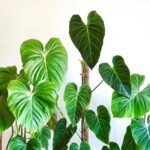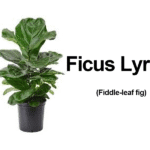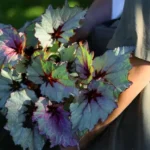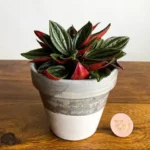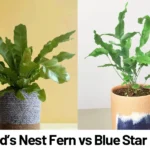Introduction
Dieffenbachia ‘Reflector’ is one of the most visually striking foliage plants you can add to your indoor plant collection. Often admired for its unique mosaic-patterned leaves with deep green and neon-yellow speckling, this cultivar is part of the popular Dieffenbachia genus, also known as dumb cane. ‘Reflector’ is particularly beloved by plant enthusiasts for its low-maintenance nature combined with its bold, tropical appearance. If you’re looking for a statement piece that thrives indoors and requires only moderate care, Dieffenbachia ‘Reflector’ could be the perfect choice.
Understanding Dieffenbachia ‘Reflector’
Dieffenbachia belongs to the Araceae family and hails from tropical regions of Central and South America. The cultivar ‘Reflector’ gets its name from its shimmering leaf patterns that appear almost reflective under certain lighting. Each leaf features deep green bases with chartreuse and lime speckles, often accented by a lighter, central midrib. This dense foliage creates a lush, jungle-like ambiance and instantly adds texture and vibrancy to home interiors.
Despite its exotic look, ‘Reflector’ is relatively easy to grow. However, like all Dieffenbachias, it contains calcium oxalate crystals that make the plant toxic to pets and humans when ingested. Caution is advised, especially in homes with curious pets or young children.
Ideal Growing Conditions
Light Requirements
Dieffenbachia ‘Reflector’ prefers bright, indirect light to flourish. Direct sunlight can scorch its leaves, leading to scorched edges or faded patterns. A few hours of early morning sun from an east-facing window or diffused light from a bright southerly exposure work well.
- Too little light: Can lead to leggy growth and faded variegation.
- Too much direct light: Causes burning or yellowing of the leaves.
If natural lighting is insufficient, especially during winter months, supplemental lighting from LED grow lights can keep your Reflector thriving.
Temperature and Humidity
As a tropical plant, Dieffenbachia thrives in warm, humid environments. Ideal room temperatures range between 65°F to 80°F (18°C to 27°C). Avoid sudden temperature drops, drafts, or exposure to temperatures below 60°F (15°C).
Humidity should ideally be over 50%. In dry climates or central-heated homes, consider the following:
- Use a room humidifier
- Group plants together for a microclimate effect
- Place the pot on a pebble tray with water (without touching the pot’s base)
Soil Mix
Dieffenbachia ‘Reflector’ prefers well-draining soil with good aeration. A suitable mix includes:
- 2 parts high-quality indoor potting mix
- 1 part perlite for airflow
- 1 part coconut coir or peat moss for moisture retention
This custom blend ensures the roots get enough moisture without becoming waterlogged — the most common cause of root rot in indoor plants.
Watering and Fertilization
Watering Schedule
Understanding your plant’s watering needs is critical. Dieffenbachia prefers to dry out slightly between waterings. A good rule of thumb is to water thoroughly once the top 1-2 inches of soil are dry.
Water improperly, and your plant may show signs like:
- Underwatering: Curling or crispy leaf edges
- Overwatering: Yellowing lower leaves and mushy stems
Always use lukewarm, filtered water if possible, as Dieffenbachia can be sensitive to salts or chemicals in tap water.
Feeding Your Reflector
Feed your Dieffenbachia ‘Reflector’ during the active growing season—usually from spring through early fall. A balanced houseplant fertilizer, diluted to half strength, works well every 4–6 weeks.
Avoid fertilizing in the dormant winter months when the plant naturally slows its growth. Overfertilizing can result in nutrient buildup, causing leaf burn and root damage.
Pruning, Repotting, and Propagation
Pruning
Dieffenbachia generally maintains a neat growth habit but can benefit from occasional pruning:
- Remove dead or yellowing leaves to maintain plant health and appearance
- Pinch back leggy stems to encourage bushier growth
- Use sterilized shears to avoid spreading pathogens
Always wear gloves when pruning, as Dieffenbachia sap can irritate the skin and eyes.
Repotting
Repot your Dieffenbachia ‘Reflector’ every 1–2 years, or when you notice roots growing from the drainage holes. Choose a pot that’s 1–2 inches larger in diameter and ensure it has adequate drainage. Repotting is best done in spring or early summer.
Propagation
Propagation of Dieffenbachia ‘Reflector’ is best achieved via stem cuttings. Here’s a simple method:
- Choose a healthy, mature stem and cut a 4–6 inch section with at least one node
- Let the cutting callous over for a few hours
- Place the cutting in water or moist sphagnum moss
- Keep it in a warm, humid environment with indirect light
- Transplant to soil once roots are 1–2 inches long
Be patient—rooting can take several weeks. Ensure the cutting does not rot by changing water regularly or keeping moss just slightly moist.
Common Issues and How to Solve Them
Like many indoor plants, Dieffenbachia ‘Reflector’ can sometimes experience issues. Here are common problems and how to address them:
Yellow Leaves
Often caused by overwatering or poor drainage. Check your watering habits and improve soil aeration or repot if needed.
Browning Leaf Tips
This could be due to low humidity, salt buildup from fertilizer, or inconsistent watering. Increase humidity and flush the soil monthly with distilled water.
Pest Problems
While generally resilient, your plant can still attract pests like:
- Spider mites: Fine webbing and stippled leaves
- Mealybugs: White, cottony clumps at leaf axils
- Scale: Hard, brown bumps on stems or leaves
Treat with insecticidal soap, neem oil, or isolate the affected plant and gently wipe pests with alcohol-soaked cotton swabs.
Tips for Happy, Healthy Growth
- Rotate your plant every few weeks to maintain symmetrical growth
- Dust the leaves regularly with a damp cloth to help with photosynthesis
- Keep it on a plant stand or elevated shelf to showcase its foliage
- Avoid moving or repotting frequently unless necessary, as it can stress the plant
Conclusion
Dieffenbachia ‘Reflector’ is a gem among indoor foliage plants. With its exotic leaf patterns, easy-care nature, and tropical elegance, it’s well-suited for plant enthusiasts of all levels. By understanding its specific needs—adequate light, humidity, consistent watering, and the occasional feeding—you can enjoy a thriving plant that enhances any indoor space. Whether you’re just beginning your plant journey or expanding a well-loved collection, this stunning cultivar is sure to reflect your love for indoor gardening in the brightest way.
References
- Petruzewicz, E. (2023). Houseplants Made Easy. Green Life Publications.
- Rauch, F. D., & Stack, L. B. (2021). Dieffenbachia: Care and Growing Tips for Modern Indoor Spaces. Urban Gardening Press.
- University of Florida IFAS Extension. (2019). “Dieffenbachia: A Popular Indoor Plant.” Retrieved from https://edis.ifas.ufl.edu/ep059


